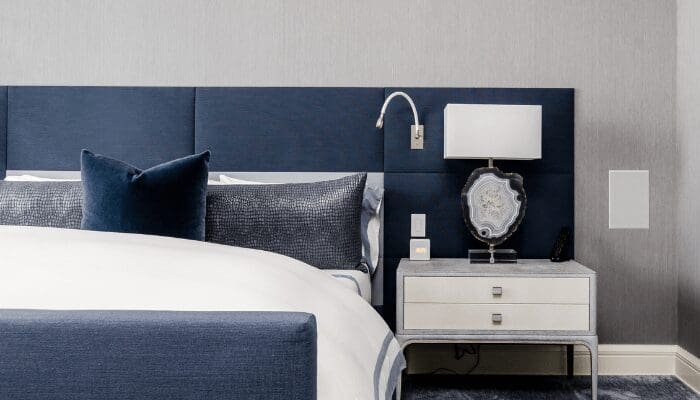10 Basic Home Staging Tips for Design-Challenged Home Sellers
- Published on
- 7 min read
-
 Whitney McKinnon Contributing AuthorClose
Whitney McKinnon Contributing AuthorClose Whitney McKinnon Contributing Author
Whitney McKinnon Contributing AuthorWhitney McKinnon is a professional writer whose work has recently appeared on Yahoo, SlickText.com, HelloGiggles, Bolde, and The Hoth.
At HomeLight, our vision is a world where every real estate transaction is simple, certain, and satisfying. Therefore, we promote strict editorial integrity in each of our posts.
To those without an eye for design, suggestions to stage your house before you sell it can sound like a foreign language. Vague concepts like “help buyers visualize your home as theirs” and “make sure rooms flow” feel good in theory, but how do you execute on it?
Though in some cases professional staging could be the best route, there are a number of DIY staging techniques sellers can do around the house to help get it ready for photos and showings, too. We’ve dug up these 10 highly actionable home staging tips for sellers that don’t require years of interior design experience or an artist’s brain.

1. Apply a fresh coat of paint to dark interior walls.
You may love that dark gray shade that you selected for your living room years ago, but your prospective buyers may not agree—especially if they’re first seeing your home online in photographs.
“We never have buyers that come to us and ask for a dark house,” explained John Fudge, a former interior designer and top agent in Huntsville, AL with nearly 20 years of experience selling real estate. “Every buyer wants a light, open, airy space.”
You don’t have to be Picasso to paint over gloomy walls with a fresh coat of color that exudes that luminous glow buyers seek.
The science behind color tells us that when you paint a room white, the walls will reflect the room’s natural light and open up a space without you having to remodel or add square footage. Darker colors can be dramatic, but they’ll suck up light and color instead of brightening the room’s aura.
Try a neutral paint color like Behr’s Candlelight Ivory, Benjamin Moore’s Silver Satin, or Glidden’s Smooth Stone. Shades like these are light enough to photograph well and will play nicely with the beams of sunlight that come in through the windows during daytime showings.
2. Clean up your bathroom decor.
Your bathroom might not take up much space in your home’s floor plan, but if it’s not staged correctly, it can turn off buyers faster than you realize. Don’t worry—we’re not suggesting you try pull together a shabby-chic or beach-inspired theme on a whim. No floral patterns or jars of sea shells required.
In fact, what most homeowners want is a contemporary bathroom style, defined by Homestratosphere as “open space, straight lines, clutter-free…[a] clean, fuss-free environment.”
“When in doubt, ask yourself what a luxury hotel would do,” advised Justin Riordan, founder of West Coast home staging company Spade and Archer. “What color towels would a luxury hotel use? Hotels use white towels because they show dirt. They do this on purpose because they want you to see how clean they are.”
Use this hack in your own bathroom by stocking up on fluffy white towels and accessories, as well as a white shower curtain. When it comes to staging your bathroom, a super sanitized look should be the goal.
3. Make sure your home is appealing to all five senses.
Staging a home isn’t just a visual job. You’ll want to make sure your space appeals to the senses beyond sight. Your buyers will need to fall in love with the smells, sounds, and textures of the home before making a major commitment to it.
For some homeowners, this may mean being extra diligent about cleaning up after Fido and Mittens. Pet toys should be kept out of sight, and litter boxes will need to be kept in pristine condition. Authentic freshness beats artificial air fresheners every time.
In addition to eliminating pet odors, homeowners should pay attention to the textures and feel of their home. Staging a home with comfortable furniture can help prospective homeowners to feel more at ease in a new space. Throw pillows, soft blankets, and using lots of pleasant textures expressed through furnishings like faux-fur rugs appeals to the buyer’s desire for comfort.
Bonus points if you’re able to play some soft background music to make your space appealing to your target audience. Selection is key here; you won’t want to be playing Ariana Grande’s latest jams when showing your home to a retired couple looking to downsize. Think more along the lines of smooth jazz (and turn it down a notch!)

4. Declutter your closet until the floor is completely clear.
This task is among the most daunting home staging tips for sellers, but anyone can clean a closet if they put their mind to it. Buyers will open up every door in the house, so organizing your closets like a showroom can pay off.
“We’ll advise that a seller clear the floor space out completely, neatly fold and stack things on shelves—in my opinion, things can go all the way to the ceiling if they have to,” said Fudge. “Just not necessarily looking like the space is completely full, so that a buyer doesn’t feel like the person that’s living there is busting at the seams.”
A closet organizing system (like this freestanding closet storage kit or this wall-mounted organizer from Home Depot) can be a lifesaver when it comes to getting your closet floor 100% clear. In addition, replace any clear storage containers in your closet with opaque ones, like these bins from Lowe’s. This small swap can go a long way in reducing unappealing eye-clutter for your potential buyers.
5. Use paint to refresh rather than replace where you can.
Buyers are turned off by even the most innocuous of eyesores. In some of these cases, you might be better off grabbing a can of paint from your local hardware store than going all out to replace otherwise functional items in your home.
“Let’s say you have a tired-looking front door,” said Justin Riordan. “Pick a bright and fun paint color in a high gloss that coordinates with the rest of the paint on your house. First off, remove the screen door, store it in the garage… Second, paint the door. Third, replace the existing hardware with new easy-to-operate deadbolt and entry latch.”
Good as new, and you don’t have to shell out cash for a brand new front door.
Other areas where you might be able to get away with painting instead of replacing include:
- Bathroom tile:
Cover up blemishes, chips, or gaudy colors with a coat of low-resin paint (see this drastic bathroom DIY improvement project that transformed stained, reddish tile into a fresh modern look using Benjamin Moore Platinum Gray Floor Patio paint.) - Cabinets:
Freshen updated cabinets with latex paint (don’t forget the primer)—as for color recommendations? Try white or dark gray. - Porches and decks:
Power wash surfaces (you can rent a pressure washer from Home Depot) and then use Consumer Reports’ Wood Staining Guide to find an attractive, long-lasting stain for your project that matches your house and materials. - Wood paneling:
Apply a thin coat of primer followed by a glossy white paint to instantly transform dated wood paneling into a clean, bright aesthetic.
Just make sure to chat with your listing agent before making any major (or permanent) changes to your space. Once you paint wood, for example, it’s hard to go back.
6. Modernize your lighting fixtures.
Unflattering light fixtures make even modern homes feel unnecessarily dated. Swap out older fixtures for fresh, contemporary styles. A rustic yet elegant chandelier (like this one from Progress Lighting) or a cluster of pendant lights can take your staging look from drab to fab in no time.
While you’re at it, replace your incandescent or fluorescent bulbs with LED lighting. LED is far and away the closest bulb to mimicking natural light, making it the next best thing after the warmth of real natural lighting.
LED bulbs tend to cost a little bit more than their alternatives, but the light quality, energy efficiency, and long-lasting nature of the bulbs make it a worthwhile switch.

7. Keep the master bedroom gender neutral.
The master bedroom is the second most important room to stage, according to the National Association of Realtors, trailing only the living room as the most important staging location.
Not all staging is created equal in part of the home where comfort is paramount. To create a feeling of belonging no matter the audience, opt for a neutral color scheme when it comes to your master bedroom decor.
This isn’t the time to bring out pink floral bed skirts or nautical-themed items. Instead, layer on comfortable textures in neutral colors (like these nubby throw pillows or this clean-looking linen bed skirt) for an interesting yet cohesive look that doesn’t leave any potential buyers out in the cold.
8. Put those awkward spaces to work.
Areas in your home containing weird angles or limited space can seem difficult to work within everyday life, but they can be used to your advantage when it comes to staging your home.
“Don’t be afraid of adding two living areas to one space, especially if the space feels a little awkward,” said Maisie Knowles, a certified interior designer in Colorado. “Sometimes the best use of space is for the main living area and a reading nook just beside or behind it.”
To create your own book nook, place a soft chair in a corner, add an extra small coffee table or ottoman, and tie it together with a few final touches: a book, a succulent and tea cup positioned on a tray, and a fuzzy throw will show buyers the potential of any small space.

9. Use outdoor lights to highlight your curb appeal in the dark.
When the outside of your home is staged correctly, every drive-by can be an opportunity for a potential sale. In a lot of cases, those opportunities may arise after dark. That means you need to be prepared with great lighting to illuminate the outside of your home after the sun goes down.
A lot of buyers in the market for a new home will conduct drive-bys after they get out of work, often around dusk.
Proper lighting and staging can make your home look as appealing as possible any time of day. If your home has a walkway, consider installing a few solar powered lights along the path. A well-placed string of lights can make a porch look magical, especially when combined with an attractive porch light or streetlight to cast a soft glow.
10. Get up on your tiptoes and down on your knees for a deep clean.
The most important home staging tip that all of the experts stress: make sure your space is spotless. We’re talking immaculate, spring-cleaning-on-steroids levels of cleanliness.
Baseboards, walls, light fixtures, shelves, windows: they all need to be given a good wipe down before you open your doors. Be prepared to apply lots of elbow grease for especially hard-to-clean areas.
Jack Prenter, founder of ChoreBliss, a residential cleaning company in Toronto, recommends getting down to the dirt’s level.
“It’s incredibly hard to see dirt at angles that aren’t parallel to it. A great example that we often see missed is dirt on the edges of the mirror,” said Prenter. “Get on your tiptoes or crouch down to look under and around every surface, piece of furniture and appliance in the home.”
If you’ve got an especially dirty job, don’t hesitate to call in a team of professionals to do a deep clean on your home. You’ll be glad you did when that first offer comes rolling in. As Prenter put it, “nothing ruins the mood more than a dirty finger after touching a fixture in a home that’s supposed to be flawless!”
Bonus home staging tip: Get a top agent’s take on your individual property
Ultimately, a local real estate agent will know what works and what doesn’t for the target audience in your area. They’ll be able to guide you in the right direction so you don’t have to worry about spending money on unnecessary upgrades for the sake of staging.
The main purpose of staging is to give your home’s true beauty a chance to shine through in its simplest form. Start with these tips, and ask your agent to fill in any gaps based on your unique property and what buyers in the area want to see. You fell in love with your home for a reason; show your buyers why they will, too.
Article Image Source: (Kari Shea/ Unsplash)
